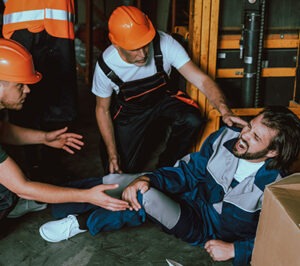Construction accidents, unfortunately, remain a common occurrence in the United States, and especially in New York City. According to the NYC Department of Buildings (DOB), there were 586 injuries and 11 deaths related to construction accidents in the city in 2019. Six of the deaths happened in Manhattan. Even more shockingly, these fatalities can sometimes be underreported when official statistics are compiled each year.
Although the number of construction-related injuries in NYC has declined relative to previous years, these figures remain higher than those from 2015 and construction is still considered the most perilous industry in NYC, per a story from CBS Local published in 2019. Fatalities are up 33% relative to 2015.
Causes Of Construction Accidents
The four most frequent types of construction-related injuries are falls, being struck by an object, being caught under or between an object, and electrocution. Common causes of construction accidents include:
- Defective ladders and scaffolds
- Improperly built scaffolds
- Falling objects that should have been secured
- Partial building collapses
- Sharp objects (like saws, nails, and broken glass) left lying around within passageways
- Improper use of cranes and forklifts
Other more intangible and organizational causes of construction accidents include:
Profit over people and budgeting decisions: One common way of cutting budget costs involves reducing the workforce and circumventing safety procedures, which is evidently risky.
Deadlines: Especially in the construction industry, you hear them say “this needs to be done yesterday.” Contracts may include late fees and penalties so impending deadlines can lead to shortcuts especially when it comes to how work is done and worker safety.
Improper training: Whether it’s complying with OSHA 30 or even attending the toolbox talks on site, some contractors and job sites adhere to it and unfortunately some don’t.
New York’s Construction Labor Laws
Under New York State labor laws, construction company owners and contractors are required to ensure that all areas they control are “reasonably safe” for all workers, per Labor Law 200. That includes the job site itself, the equipment and machinery that is being used and also the methods by which the work is being done. Section 200, is in essence, what we call “common law negligence.” This section of the Labor Law is narrow in that you need to show that the owner and general contractor on the job site in some way controlled and directed the work that resulted in the injury that a construction worker suffered and in many cases, the work that was being done at the time is usually controlled and directed by one’s own employer and not by the owner or the General Contractor. In addition to the work that is being done, the owner and general contractor are responsible for dangerous conditions on the job site like structural defects and conditions as long as they knew about the condition, or the condition existed for such a sufficient period of time that they should have known, observed or identified the condition.
Section 240(1) of New York’s labor laws, which is commonly referred to as the “Scaffold Law” provides protection for a construction worker in relation to what the courts refer to as “gravity-related” incidents, i.e. falls from a height such as a ladder or a scaffold, scaffold boards collapsing and causing construction worker to fall, falling through a hole on the job site and also falling object cases, for example where an object that should have been secured falls, strikes and injures a construction worker. This section of the labor law provides great protection to the worker and holds the owner and general contractor on the site, absolutely liable for a gravity-related incident as long as the worker was not 100% at fault for his own incident. WHAT DOES THIS MEAN? It means that even where the construction worker may have contributed to the incident if it’s shown that he/she wasn’t afforded proper protection, the owner and general contractor are 100% at fault. A simple example of this would be where a construction worker who is on a ladder that can’t be tied off or doesn’t extend the requisite three (3) feet above the roof or parapet falls from the ladder when he/she overreaches to grab a tool. The worker, in that case, contributed to his accident in overreaching but the fact that the ladder couldn’t be tied off or didn’t extend above the roof is a violation of the labor law and the owner and general contractor are then held completely at fault. Once it can be shown that there was a violation of any type, irrespective of whether the owner and general contractor was even aware of such a violation or dangerous condition, they ( the owner and GC ) will be held 100% at fault for the incident and the resulting injury. This section of the law was brought in to provide great protection to construction workers and by holding the owner and general contractors responsible, the law imposes upon them the responsibility of making sure that all contractors and subcontractors on-site work safely and in conjunction with the rules and regulations for construction.
You deserve Moore Justice
(917) 809-7014We are 100% committed and dedicated to maximizing your recovery and obtaining the justice and compensation that you deserve.
The third major section is Labor Law Section 241(6), which relates to construction, excavation, and demolition on sites. The section states that “all areas in which construction, excavation or demolition work is being performed shall be so constructed, shored, equipped, guarded, arranged, operated and conducted as to provide reasonable and adequate protection and safety to the persons employed therein or lawfully frequenting such places.”
This section provides and requires that work is performed in a safe manner and protects workers from exposure to safety hazards that can result in serious construction injuries. This section of the Labor Law specifically refers to Section 23 of the New York Industrial Code which lays out and specifies the rules related to construction, demolition and excavation activities. Whether it relates to the height a ladder can extend above a roof, the maximum weight or load allowed on a scaffold, the condition of a construction site passageway, the sufficient amount of lighting required in a construction site area and the proper condition of power-operated equipment, this section lays out specifically the rules and requirements for each contractor and construction site to operate by. In order to be successful under this section, you must prove a violation of a sufficiently specific provision of the Industrial Code. This is where an experienced construction accident attorney is needed, someone who can navigate the specific sections of the Labor Law and in particular Section 23 of the Industrial Code.
If you or a loved one have been involved in a construction accident, call the construction accident attorneys at the Law Offices of Darren T. Moore PC for a free consultation.
What To Do After A Construction Accident
Firstly, we tell each and every client that we speak with, if you have been injured in an accident of any kind, seek medical attention. After that, there are important steps to take in order to protect yourself and any future claim you may bring. You should:
- Report your accident to a foreman or supervisor
- Take photos and videos of the area and circumstances of your accident, or ask someone to take pictures for you if you are unable to due to injuries
- Gather all relevant information from any witnesses, including names and contact details, or ask someone to do it for you if you are unable to due to injuries.
- Request that your employer alert workers compensation of your accident
As soon as practicable, you should consult a construction accident attorney to protect your rights. If you have sustained an injury at work on a construction site in New York, an attorney can file a claim on your behalf for you to receive workers’ compensation benefits. Workers’ compensation benefits will cover your medical treatment as a result of the injuries suffered along with paying your lost wages up to a maximum of $934.11 per week.
At The Law Offices Of Darren T. Moore PC, our construction accident attorneys will work tirelessly to ensure you receive the compensation you deserve following a construction accident. Our construction accident attorneys have extensive knowledge of both New York labor laws and regulations established by the Occupational Safety and Health Administration (OSHA) and the New York Industrial Code. The types of compensation you can potentially recover include damages related to:
- Pain and suffering
- Past and future medical expenses
- Past and future loss of wages, earnings, and benefits



